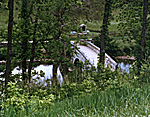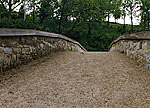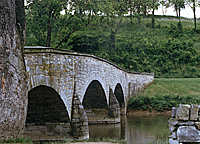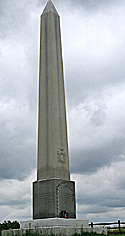Burnside's Bridge
General Ambrose Burnside, posted on the left of the Union line with IX Corp, was supposed to attack the Confederate right across Antietam Creek to tie down troops.
 All morning he attacked across the Lower Bridge (formerly the Rohrbach Bridge and now forever known as Burnside's Bridge, see photo at right), a stone bridge across a slow-moving, shallow creek.
All morning he attacked across the Lower Bridge (formerly the Rohrbach Bridge and now forever known as Burnside's Bridge, see photo at right), a stone bridge across a slow-moving, shallow creek.
Confederate Colonel Henry Kyd Douglas, a native of Sharpsburg, talked about the creek after the battle. "Burnside and his Corp might have executed a hop, skip, and a jump and landed on the other side," he said. "One thing is for certain, they might have waded it that day without getting their waist belts wet in any place."
Yet Burnside focused entirely on the bridge. From approximatley 9:30 a.m. on, his troops tried to cross in the face of 500 Georgian troops and a company of South Carolinians, posted in rifle pits atop the steep slopes that start from the very end of the bridge. There is a narrow 10 yards of open ground to the right of the bridge (from a Union viewpoint), where the road continues to the north 500 yards before turning east towards Sharpsburg. To the left of the bridge is tangled undergrowth as the slope plunges into the creek.
Total bridge length end-to-end is about 54 yards. The bridge is approximately 3+ yards (10 feet) across for 36 of those 54 yards (the middle section). At either end of the bridge, the bridge flares out over the course of 9 yards, presumably to aid wagons in making the tight turns needed to get on the bridge, until it is 10 yards wide. The stone side walls are approximately 1 foot thick and one yard high.
Antietam Creek is about 30 yards wide (at the time of the visit, June 1997). A stone wall approximately 1 yard high lines the creek on the Union side for 250 yards, upriver (north) of the bridge. A split rail fence lines the river south east of the bridge (down river) for 400 yards, until the river makes a sharp hairpin turn due west.
The Union side of the bridge offers an area 50 yards wide that was clear in 1862. Woods run back up the slope to the east, but a wide open field, evident in a period photograph, works up the hill just south of the bridge.
View of Confederate positions from Union perspective. The bridge is about 10 feet wide. Larger version of Bridge photo (slow: 143K)
It is no wonder than approximately 500 entrenched men held off 12,000 men of a Union corp for the better part of four hours.
Success at Last
The failure to cross allowed Lee to pull troops from the area to reinforce Jackson at the Cornfield and stabilize the line behind Bloody Lane. Still, Burnside kept trying to cross the bridge. By about 1:00 p.m., his troops, aided by a pincer movement through Snavely's Ford, some 1500 yards south of the bridge as the crow flies, but some 2500 yards if you follow the bends in the creek, finally dislodged the Georgians.
It is two hours later, or about 3:00 p.m., before Burnside got his corp moving again, storming towards Sharpsburg and apparent Union victory. Although the Confederates stalled Burnside as much as possible, standing behind every fence and wall possible, Lee had no reserves, the Union had overwhelming numbers finally advancing, and McClelland finally looked to be the general to beat Robert E. Lee.
A.P. Hill to the Rescue
Earlier in the day, back at Harper's Ferry, General Ambrose Powell Hill received Lee's order to march immediately for Sharpsburg--17 miles away. Hill pushed his men hard, losing almost half of them to straggling, but the blistering march continued until he reached the Sharpsburg area around 4:00 to 4:30 p.m..
Hill immediately pitched his tired troops into the flank of Burnside's troops, who may have been further confused to find the Confederates wearing blue (uniforms captured at Harper's Ferry and being put to use).
According to the inscription on the Zouave monument, of 373 members present (two of the Regiment's companies were posted elsewhere and were not at this point on the battlefield), 54 were killed, 158 wounded, and 28 were missing.
Burnside's corp was rocked back 1500 yards to the heights around the bridge as the battle gradually died down by 6:00 p.m.
Antietam
This article appears in MagWeb (Magazine Web) on the Internet World Wide Web. At right and left, Confederate views of Burnside's Bridge from commanding heights. Rifle pits were dug in among the vegetation.
At right and left, Confederate views of Burnside's Bridge from commanding heights. Rifle pits were dug in among the vegetation.

 Above the bridge on the Confederate side runs a steep ridge 50 yards high that gradually levels out as you reach the plateau above the creek. This ridge, running south of the bridge, remains steep, wooded, and full of tangled undergrowth to Snavely's Ford.
Above the bridge on the Confederate side runs a steep ridge 50 yards high that gradually levels out as you reach the plateau above the creek. This ridge, running south of the bridge, remains steep, wooded, and full of tangled undergrowth to Snavely's Ford.
 To the north of the bridge, the steep ridge gradually tapers to a gentle slope, from wooded to open fields, over the course of 500 yards.
To the north of the bridge, the steep ridge gradually tapers to a gentle slope, from wooded to open fields, over the course of 500 yards.
 The NY 9th Regiment, "Hawkins Zouaves," reached the high point of the plateau, now marked by the Zouaves monument (at right), and looked upon the town of Sharpsburg, a scant few hundred yards away. Lee was finished.
The NY 9th Regiment, "Hawkins Zouaves," reached the high point of the plateau, now marked by the Zouaves monument (at right), and looked upon the town of Sharpsburg, a scant few hundred yards away. Lee was finished.
Introduction to Antietam Battlefield
The Campaign
Morning Phase: The Cornfield
Midday Phase: Bloody Lane (Sunken Road)
Afternoon Phase: Burnside's Bridge
Conclusion: Aftermath
Back to List of Battlefields
Back to Travel Master List
Back to MagWeb Master List of Magazines
© Copyright 1997 by Coalition Web, Inc.
Other military history articles and gaming articles are available at http://www.magweb.com